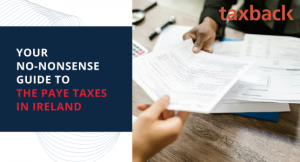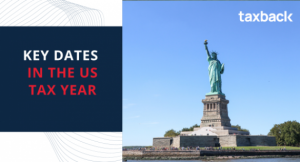The Complete Guide to Your J1!
Spending your summer on a J1 work and travel programme in the US is like a dream come true. Read these tips to make the most out of it!
Read the full blog below or download the guide straight to your mobile or PC here.
Topics we'll cover:
1. Getting Your J-1 visa
2. Getting a Job
3. Your US Resume
4. Cost of Living in the US
5. Finding Accommodation
6. Popular Places to Live
7. Chicago
8. San Diego
9. San Francisco
10. Boston
11. Getting Around
12. By Air
13. By Train
14. By Car
15. Getting Your Tax Back!
Getting Your J-1 visa
If you want to go on a J1, it's advisable to use a well-established J1 visa provider. In Ireland, the two main J-1 providers are USIT and SAYIT Travel. These companies specialise in providing J1 packages for students including the visa and flights. Among many benefits, they will also organise a US sim card, offer expert advice when it comes to jobs and accommodation, and help negotiate cheaper flights to popular J1 destinations. The price of the package usually includes insurance and the provision to change your travel dates without penalty – useful in case you need to come home to repeat an exam!
Getting a Job
.jpg)
With new legislation introduced by the US Government, you need to secure a job before you enter the US on a J1.
Remember, there are certain jobs you CANNOT do:
.jpg)
So, what jobs can you do?
You must get a seasonal job that doesn’t take a position away from a US citizen.
These types of jobs typically include:
- Work in summer camps
- Theme parks
- At resorts
- Waitressing
- Bar/restaurant work
- In hotels
- Retail jobs
How to find a job?

There are various ways to find and secure a job for your J1 including:
1. Job Fairs:
Ask your agency (USIT or SAYIT in Ireland) or search online for job fairs in your area. These usually take place at the start of the year a few months before you leave for the summer.
2. Job Placement Programmes:
Ask your agency about a job placement programme with a sponsor who will match you with a potential employer. For example, SAYIT in Ireland place people on a programme with their US sponsor InterXchange.
3. Search Online:
Research jobs online and join Facebook groups specific to your area and ask other members for advice.
Some useful websites for jobs:
4. Contacts:
Ask family and friends for employer contacts. People who have been through the process already are an invaluable source of information!
Your Application
Ensure you have a US style resume to apply for jobs. It should be one page listing your educational and work experience.
Here is what it should look like:
Get some references and always personalise your application for each job, writing a different cover letter aimed at each job. Once you land an interview, even though it may be a seasonal job, make sure you dress appropriately as you would for any other interview. You may not get another job offer, so even if you’re not happy with the first job you get, take the first offer. You can keep looking in the meantime!
How much money is required to be comfortable?
You need to have proof of funds when you enter the US on a J1 and that’s about €800 minimum with a job. It’s advisable to have enough cash to cover a hostel for a few weeks at least. €1,000 minimum should keep you going for a month or so until you find a place to live and start working.
Get your free tips on travel, taxes and more with Smart Trip!
Which city would be the best for getting work?
.jpg)
Don’t pick a city purely based on where you think you will get a job. Jobs are harder to come by in California but if you do your research and start early, you will find something!
Consider what type of holiday you would like; big city living with a busy nightlife in New York or chilling on the beach in San Diego-the choice is yours! Think about what type of job you would like; waitressing on a cruise-boat in Chicago or cleaning up hotel rooms in San Francisco!
There are some areas in the US where you’re not permitted to work:
- Alabama Gulf Shores Region
- Florida Panhandle (Apalachicola, DeFuniak Springs, Destin, Fort Walton Beach, Marianna, Panama City, Panama City Beach, Pensacola, and Tallahassee)
- Southern Florida
- North Dakota
- Inland Maryland
- Mason, Ohio
- Nebraska
- Iowa
- Pennsylvania
Cost of Living
Some states are cheaper than others. It's probably not the best way to choose where you want to go but here are the 10 cheapest and 10 most expensive states to live in. Each state is ranked by its cost of living index as of the first quarter of 2014.
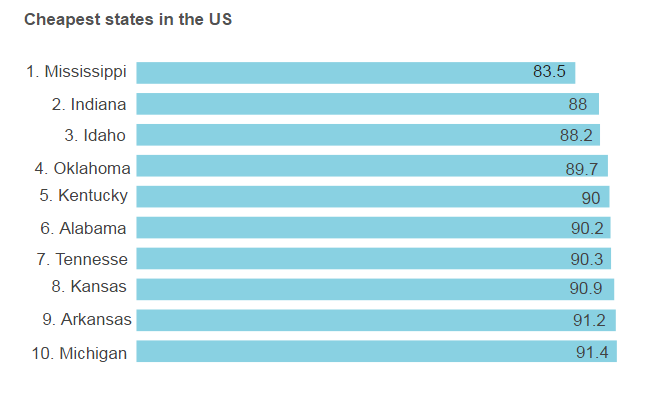
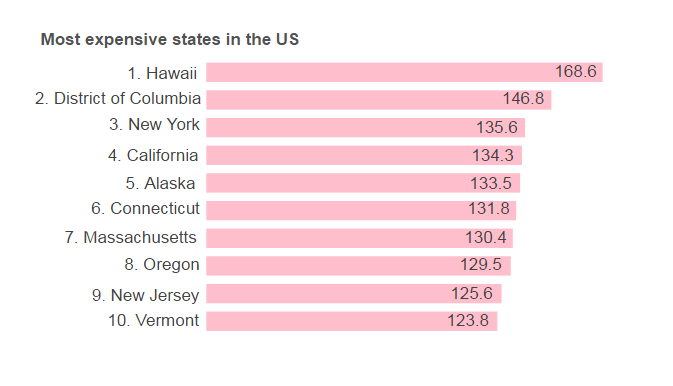
Average Daily Costs
Keep in mind that you should at least get paid in line with the cost of living, and anyway, the best way to decide is to research and chat to friends and family! Then choose what type of holiday you would like!
Finding Accommodation:

Once you know where you’re going, it’s a good idea to book a week minimum in a hostel, Airbnb, or hotel so you have a place to stay while you go apartment hunting.
Tips for finding summer rentals:
- Watch out for scams!
- If possible, don’t pay by cash and ask for a receipt
- It’s a good idea to see the place before handing over money
- Don’t sign a lease for longer than you intend to stay
- Research the neighbourhood-safety/good public transport
- Share with friends to save money
- Don’t overcrowd your accommodation
- Ask your visa service provider for advice
- Take photos when you move in, so you won’t be liable for damage you didn’t cause!
- Make sure all the rent is paid before you leave
Popular places for J1 students:
Chicago

Referred to as the windy city, Chicago is a lively place to work and live in. It has a vibrant history and is home to two major league baseball teams; the Chicago Cubs and the Chicago White Sox. Despite its name, Chicago isn’t just windy. The summers are hot and humid and the winters are cold and snowy.
The Jobs
There are plenty of jobs to be had in Chicago but you should focus on certain areas. The cruise boats on Navy Pier often employ seasonal workers and there are plenty of opportunities at the IMAX theatre, the Pier Park or in bars if you’re over 21. Waiting on tables in one of the many city’s restaurants or pubs is also a hugely popular option for J1ers.
The Accommodation
Cheap accommodation is almost impossible to find in the CTA (Chicago Transit Area). Instead many J1 students look to areas such as Wrigleyville, Lakeview and Boystown.
You can easily get into the centre from these areas on public transport. Be careful booking accommodation and always see the place before you hand over any cash!
The Fun Stuff
Enjoy the many amusements, bars and entertainment at Navy Pier on your day off. It’s the perfect destination to see a fireworks display with bi-weekly shows over Lake Michigan and you can watch them all from the comfort of a pier cruise or along the dock.
Millennium Park
For a cheap day out, head down to Millennium Park for free concerts, events and exhibitions.
Taste of Chicago
The world’s largest food festival, the Taste of Chicago, takes place in Chicago from 6 July to 10 July in 2016 in Grant Park. Sink your teeth into piping hot pizza as you lie back on the grass and enjoy music concerts from local and touring acts.
San Diego
.jpg)
As Lonely Planet describes it, San Diego, California, is ‘’sun, surfs and sunsets’’. The city is becoming increasingly popular for J1'ers seeking out the laid-back lifestyle of the beach blended with the vibrancy of a big city.
The Jobs
The seasonal jobs market is competitive here so you’re better off start searching early.
Useful websites:
- jobstar.org/sd/adjobs/summer
- collegegrad.com/job/sandiegosummerjobs
- groovejob.com/browse/jobs/in/CA/California/San%20Diego
- sandiego.craigslist.org/
Places like Petco Park, Del Mar Races, and theme parks like Legoland or the San Diego Zoo all hire seasonal workers. There are also plenty of waiting positions in the many bars and restaurants or seasonal work as housekeeping assistants in some of the big hotels.
The Accommodation
It can be difficult to get accommodation in San Diego so you may have to search for a few weeks. Some popular locations with J1ers in San Diego are Pacific, Ocean, and Mission Beach. Other places to live within easy reach of Pacific Beach include Old Town and La Jolla and both have good public transport connections.
The Fun Stuff
Besides surfing and hanging out at the beach, San Diego has tonnes of attractions to keep you occupied on your days off.
Balboa Park is perfect for a lazy weekend stroll or cycle around the 1200 acre area. The park houses 15 museums, several arts venues and landscaped gardens that play host to hundreds of events throughout the year, with everything from food festivals to outdoor movie shows.
The historic Gaslamp Quarter is home to more than 100 stores and plenty of bars and restaurants to enjoy in a night out.
San Francisco

San Francisco is hugely popular with J1 students for its eclectic mix of people, laid-back and friendly attitudes and wonderful sites. The city and county of San Francisco is the cultural centre of California and is full of fascinating cultural and historic sites including Alcatraz, Chinatown and the Golden Gate Bridge.
The Jobs
Large hotels such as the Westin hire a lot of seasonal workers and the bars, clubs, restaurants and shops on Pier 39 are always in need of seasonal workers.
You can search these websites:
The Accommodation
A lot of J1ers choose to live in Berkeley in apartments or frat houses. The frat houses are a cheap option running around $500-$700 per room for the summer.
You can contact Berkeley directly to find a list of summer sublets at homeinfor@berkeley.edu or check out the off-campus listing here.
You don’t need to live in the centre of the city where rent is expensive, just stay close to the BART or MUNI bus routes.
The Fun Stuff
Take a walk or a bike ride across the Golden Gate Bridge and take in the breathtaking views of the city skyline.
For bargains, curiosities and fantastic food, take a tram up to San Francisco’s Chinatown, which is the oldest Chinatown in North America and home to the largest community of Chinese outside Asia. Chinatown holds many cultural delights for the tourist.
Pier 39 is perfect for an evening of food, drinks and entertainment with friends. As well as catching a view of San Francisco’s native sea lions sunning on the pier, you can watch the many street performers or musicians after dining at one of the restaurants with a view across the bay.
Take a night tour of Alcatraz, a former island prison that housed inmates such as the infamous Al Capone and Arthur "Doc" Barker. Organise your trip in advance and buy tickets online here.
Boston

Source: Robbie Shade
Boston’s streets tell the story of its history and the city was founded by Puritan settlers in 1630. With a diverse population, it’s the third most densely populated city in the US. Boston is made up of neighbourhoods where you’ll witness its historic past blended with modern thinking.
The Jobs
There are plenty of jobs available over the summer in retail and hospitality. A lot of students end up in the hospitality industry. It’s worth enquiring with the large hotel chains also to see if they take on seasonal workers, including the Westin and Park Plaza.
Some useful websites:
The Accommodation
Boston is a university hub, so it can be easy enough to get cheap accommodation throughout the summer. Popular places include Allston, Fenway and Cleveland Circle. Many of the colleges such as Harvard and MIT offer accommodation through their housing offices. SAYIT recommends avoiding Roxbury and Chinatown.
Some useful websites:
- bostonapartments.com
- werentboston.com
- BostonForRent.com
- bc.edu
- travellerspoint.com/budget-accommodation-en-ci-162.html
- apartmentList.com
Getting Around
.jpg)
Once you're in the US, you'll want to do some travellign when you're not working or when you finish your job! Remember, you'll have some time to enjoy the states after you finsih working so keep some cash for getting around!
By Air

A comfortable and quick way to get around the U.S. is to fly with a low-cost airline. There are many domestic carriers in the U.S. that offer deals and discounts including:
• JetBlue Airways
• Southwest
• WestJet
• Spirit Airlines
Tips for getting cheaper fares:
- Book early
- Search flight comparison websites such as Kayak.com or Momondo
- Be flexible about flight dates
- Take red-eye or early morning flights
- Fly to smaller cities instead
- If your trip is to a Canadian city close to the border, consider flying to a U.S. city nearby
By Train

Take in the beauty of this magnificent country with a trip on an Amtrak train. The U.S. has an excellent rail network that will take you all over the states and it doesn’t have to come at a huge price.
Tips for cheaper tickets:
- Book early
- Look for deals online
- Buy multi-way tickets
- Use your student (ISIC) card for discounts
- Look at alternative routes
- Avoid peak travel times (9.30-10am and 3-7pm)
- Don’t travel Saturdays or Sundays
- Buy a railcard
By Bus
.jpg)
Bus travel is one of the cheapest ways to get around the U.S. and Greyhound buses will take you to over 3700 places in the U.S. and 1300 in Canada. They are comfortable, air conditioned, and operate 24 hours a day with flexible fares.
Tips for cheap fares:
- Book your trip as early as possible
- Buy your ticket online and print it
- If you plan on using Greyhound a lot, sign up to their rewards scheme
- Bring water and snacks on your journey
- Always keep an eye on your personal belongings
- Arrive around one hour before your bus leaves
- Watch your personal belongings carefully
By Car
.jpg)
As a foreign national in the U.S., you must have a full driver’s license to drive. For specific requirements in the state you’re in, you should check the motor department of that state.
Some states require an international driving permit in addition to your home country’s driving license. If you’re planning a trip, it may be better to fly to the area and rent a car when you get there.
Tips:
- Make sure you get adequate liability insurance
- You’ll need a credit card to rent a car
- Most car rental companies require the driver to be at least 25 years old
- Invest in GPS navigation
- Don’t drink and drive under any circumstances
Get your tax back!
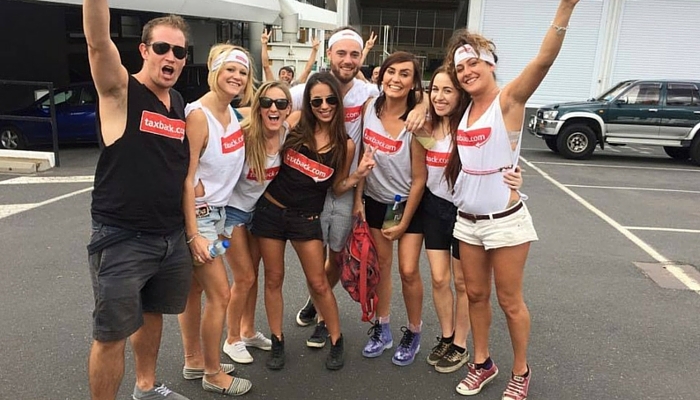
The average J1 refund is $800 so it’s definitely worth applying to get your tax back! Taxback.com can help you get your tax back without the hassle and we’ll do all the paperwork.
You can start by getting a free estimate of your refund using our online tax calculator here.
The average US tax back we get for J1 students is $800
Tips:
- Fill out a W-4 withholding form once you get a job
- Keep track of expenses as you may be able to claim tax deductions
- Keep your U.S. bank account open so you can get your refund straight to your account
- You MUST file a tax return if you earn more than U.S.$3950
- You should file your U.S. tax return by
- April 15th (this date changes if April 15th lands on a Friday or a bank holiday) of the following year
- To claim your refund, we’ll need your W2 form or final cumulative payslip and social security number/ITIN number
- If you lose your forms, we can help you find them!
- Make sure you get an address and other contact info from your employee
- Get your free tax refund estimate
Have a blast and follow us on Twitter here for news, competitions and updates!

